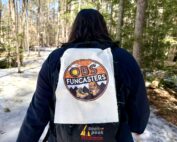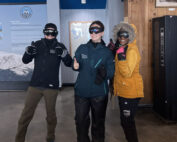Nighttime Photography on the Summit
2013-05-05 17:06:20.000 – Mike Dorfman, Weather Observer
Observer Mike D. Poses for a Long Exposure Picture
As a new night observer on the summit, I have quickly realized that the night sky and nighttime landscape, when visible, are an incredible sight. The plain blue sky that surrounds us during the day can turn into a sea of sparkling stars once the sun sets, and the surrounding landscape, barely visible under moon or starlight, turns into an eerie backdrop for my nighttime observations. Although I am quite busy at night, my midnight lunch break involves grabbing a bite to eat, grabbing my camera and attempting to capture what I see outside. Doing this can be challenging and frustrating, but it can also be extremely rewarding if the final product comes out as hoped. It seems almost like magic when the unadjusted human eye can barely see shapes in starlit terrain, yet a long exposure shot with a camera can capture extensive detail.
First, I assure you I am not a professional photographer. I have experimented with a Digital SLR (one of the larger cameras with a detachable lens that you may see people carrying around), and have slowly accumulated knowledge as I experiment. I will attempt to impart a small amount of this knowledge onto you, the reader of this comment.
One of the most important things in a night shot is to stabilize the camera. The easiest way to do this is with a tripod, but if you’re in the backcountry trying to get a night shot, a flat surface where the camera can sit and won’t rock back and forth will suffice. It is also convenient to get a remote timer, which allows you to press the shutter button without touching the camera and risking blurring the picture.
The three main variables that control the amount of exposure of the camera’s sensors to light are shutter speed, aperture, and ISO. These all have a different effect on the final picture. The ISO controls how sensitive the camera’s sensors are to light coming through the lens. A higher ISO with other variables unchanged will allow dark scenes to be lighter, however images with higher ISO’s tend to have much more ‘noise’ in them, making it look lower quality.
The aperture of your camera controls the amount of light going through the lens. The effect that this has is on the depth of field of a picture. Depth of field is the ability for multiple objects at different distances from the camera to be in focus. With a lower aperture, the image can be focused either on the foreground or on the background, however with a higher aperture the image can be focused on both. More importantly, a higher aperture means more light can hit the camera’s sensors, allowing for a more exposed picture.
The shutter speed changes the amount of time which the camera’s sensors are exposed for. The longer the shutter speed, the brighter the picture will be. Longer shutter speeds are great for capturing star trails or movement, but the camera will then be very sensitive to small movements when the shutter is open.
To get a better idea of what these three variables are, you can take a look here. Most, if not all DSLR’s allow the user to change all of these variables. If you have a point and shoot camera, don’t despair! Every camera is different, so see what variables you can change by taking a look at your camera’s manual. Even if you can’t change the ISO or aperture, most cameras allow you to change the shutter speed. Although the quality of the image may not be as flashy as those taken with professional-grade DSLR’s, you’ll still have something impressive to show your friends. Good luck!
Mike Dorfman, Weather Observer
Team Flags Return for Seek the Peak’s 25th Anniversary
Team Flags Return for Seek the Peak's 25th Anniversary By MWOBS Staff Mount Washington Observatory is looking forward to continuing a much-loved tradition for Seek the Peak’s 25th Anniversary: Team flags. In inviting teams
Meet Summer Interns Zakiya, Max and Maddie
Meet Summer Interns Zakiya, Max and Maddie By MWOBS Staff We are excited to welcome six teammates to the summit of Mount Washington this summer! During their internship, these students and graduates will play
Saying Goodbye to the Summit
Saying Goodbye to the Summit By Alexis George After an extraordinary last three years working as a Weather Observer and Meteorologist, I am excited to pursue a different career. As sad I as am






